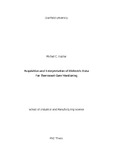JavaScript is disabled for your browser. Some features of this site may not work without it.
| dc.contributor.advisor | Partridge, Ivana K. | en_UK |
| dc.contributor.author | Kazilas, Michalis C. | en_UK |
| dc.date.accessioned | 2005-11-23T14:36:39Z | |
| dc.date.available | 2005-11-23T14:36:39Z | |
| dc.date.issued | 2003-09 | en_UK |
| dc.identifier.uri | http://hdl.handle.net/1826/97 | |
| dc.description.abstract | The interpretation and modelling of the dielectric response of thermosetting materials during cure was the main focus of this study. The equivalence of complex permittivity and complex impedance in terms of information content was outlined in a series of case studies covering the separate effects of dipolar movements and charge migration as well as the combined effect of the two polarisation mechanisms. Equivalent electrical circuits were used in order to model the evolution of the complex impedance during cure. A numerical method that can model consecutive spectra throughout the cure was developed. The method is based on Genetic Algorithms and requires only input from the modelling of the initial spectra. Complex impedance spectra were collected during the cure of a commercial epoxy resin formulation under isothermal and dynamic heating conditions. The spectra were analysed and modelled. The modelling was successful over the whole frequency range of the measurements (1 Hz – 1 MHz). The analysis of the estimated model parameters showed that charge migration dominates the dielectric response in a wide frequency range. In addition, the modelling algorithm also distinguished between the effects of electrode polarisation and dipolar movements in the signal. A new equivalent circuit was used in order to map the frequency regions where the each one of the three phenomena that together comprise the dielectric signal can be monitored most effectively. A chemical cure kinetics model was developed for the studied system. A correlation between the maximum point of the imaginary impedance spectrum and the reaction conversion was established. A mathematical model, based on a simple linear dependence of the dielectric signal on conversion and temperature, was built. The model predictions agreed well with the experimental data. The aim of simplifying the interpretation of the dielectric signals led to the development of a new experimental technique. Temperature Modulated Dielectric Analysis employs temperature modulations superimposed on an underlying thermal profile in order to separate the influence on the signal of the temperature alone from that of the cure reaction. The early study carried out here shows that such measurements are feasible and reveals important issues for its further development. | en_UK |
| dc.description.sponsorship | EPSRC | en_UK |
| dc.format.extent | 1883 bytes | |
| dc.format.extent | 4608807 bytes | |
| dc.format.mimetype | text/plain | |
| dc.format.mimetype | application/pdf | |
| dc.language.iso | en_UK | en_UK |
| dc.publisher | Cranfield University | en_UK |
| dc.subject.other | thermosetting | en_UK |
| dc.subject.other | genetic algorithms | en_UK |
| dc.subject.other | epoxy resin formulation | en_UK |
| dc.subject.other | cure monitoring | en_UK |
| dc.subject.other | temperature modulated dielectric analysis | en_UK |
| dc.subject.other | TMDA | en_UK |
| dc.title | Acquisition and interpretation of dielectric data for thermoset cure monitoring | en_UK |
| dc.type | Thesis or dissertation | en_UK |
| dc.type.qualificationlevel | Doctoral | |
| dc.type.qualificationname | PhD | |
| dc.publisher.department | School of Industrial and Manufacturing Science |
